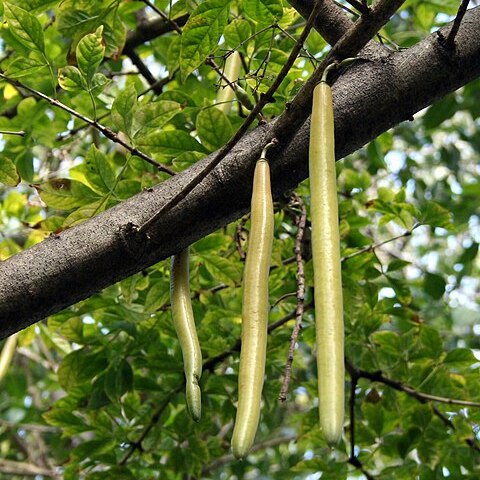Small tree to 20 cm d.b.h. and 7 m tall, usually several-branched near the base, the main branches strongly ascending, the crown open; twigs terete, subpuberulous, the nodes often double with a pair of small leaves in the axil of a larger pair, foliaceous pseudostipules sometimes present, 6-10 mm long and 3-4 mm wide. Leaves opposite, 3-foliolate; leaflets elliptic to elliptic-rhomboid, acute to acuminate, basally attenuate, the terminal leaflet 3.6-9.5 cm long and 1.4-4 cm wide, the lateral leaflets 3.0-6.5 cm long and 1.4-3.6 cm wide, membranaceous, secondary veins in 4-6 pairs, somewhat lepidote at least beneath, simple-puberulous along the midvein above and beneath, espe-cially in axils of lateral nerves, usually with a few plate-shaped glands along the mid-vein beneath, drying olive to blackish; petiolules not differentiated, petiole conspicuously winged, 2.4-6.2 cm long, the wing to 0.4 cm wide, widest apically and basally attenuate, the midrib slightly scabrous. Inflorescence a single cauliflorous flower or a fascicle of 2-3 flowers borne on abbreviated short-shoots on larger branches or trunk, the pedicels lepidote, 0.9-1.6 cm long. Flowers with musky odor, the calyx spathaceously split on the ventral side, 1.9-4.9 cm long and 0.9-2.9 cm wide, inconspicuously lepidote, at least at the base; corolla pure white, tubular with a horizontal pleat midway across the lower side of throat, slightly fleshy, 3.7-6.4 cm long and 1.8-2.9 cm wide at the mouth, the tube 2.5-4.0 cm long, the lobes basally fused, 1.0-1.1 cm long, mostly glabrous throughout, the epidermal cells apparently glandular, a few stalked-lepidote trichomes at the level of stamen insertion inside and on lobes outside; stamens subexserted, the anther thecae thick, partially divergent, 5-8 mm long, the anterior filaments 2.6-3.5 cm long, inserted 1.1-1.8 cm from base of corolla tube, the posterior filaments 2.7-3.2 cm long, inserted 1.2-1.7 cm from the base of the corolla tube, the staminode 1.0-1.9 cm long, inserted 0.9-2.3 cm from the base of corolla tube; pistil 3.1-4.8 cm long, the ovary linear-cylindrical, 7-8 mm long and 1.5-2 mm wide, glabrous with glandular epi-dermis, the ovules irregularly 8-10-seriate; disc annular-pulvinate, 1.5-2 mm long and 6 mm wide. Fruit elongate-linear, subterete in cross section, 39-54 cm long and 1.0-2.4 cm wide, glabrous to sparsely lepidote, waxy yellow, divided into a fleshy part surrounding the seeds and a fibrous central core surrounded by the seeds; seeds small, thin, 3-4 cm long and 3-4 cm wide, with a narrow but distinct mucilaginous wing.
More
A small evergreen tree. It grows 7 m tall. It develops branches from near the base of the trunk. The limbs spread and arch in an untidy manner. The leaves have 3 leaflets and are light green. The leaflets are 6.5 cm long. The leaf stalks have wings. The flowers are showy and greenish-white. They are 5 cm long. They are bell-shaped and have frilly lips. They are produced on the stems and trunk. The fruit is a capsule 54 cm long. It is a dull yellow and hangs from the trunk and branches.
Tree to 7 m, 20 cm Ø. Leaflets oblong, acuminate, 4-8 by l½-3½ cm. Flowers cauliflorous, nocturnal, white, slightly fragrant. Calyx spathaceous, 3 cm; corolla 5-6 cm. Berry pale yellow, pendent, candle-like, smooth, 30-100 by l½-2½ cm.


